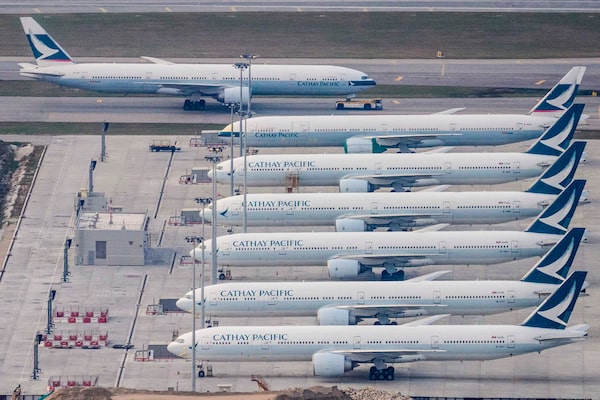
Cathay Pacific passenger planes at Hong Kong's international airport, on March 10, 2020.ANTHONY WALLACE/AFP/Getty Images
A dozen foreign airlines, including three Chinese state-owned carriers, have taken advantage of Canada’s wage subsidy program, even though many have received generous bailout packages from their own governments.
In a review of a Canada Emergency Wage Subsidy (CEWS) database, The Globe and Mail found 12 foreign airlines have received money through the program intended to help Canadian companies and their employees cope with the economic fallout of the COVID-19 pandemic.
Canadian airlines received the wage subsidy too, but want an industry-specific federal bailout.
“This is unbelievable,” Unifor president Jerry Dias said on hearing that foreign competitors got Canadian wage subsidies for workers based here. His union represents 15,000 airline workers in every sector of the industry. “You have Canada creating an even bigger economic disadvantage for Canadian airlines by subsidizing their workers in Canada when their parent companies are also giving them billions of dollars.”
The CEWS registry database shows Cathay Pacific, United Airlines, Turkish Airlines, Royal Jordanian, Lufthansa, KLM, El Al, Ethiopian Airlines and IndiGo Airlines received the wage subsidy. Three Chinese state-owned airlines – China Southern, Beijing Capital and Hainan – also got it.
Many of these airlines have received generous financial aid from their own governments, such as Hong Kong-based Cathay Pacific, and United Airlines, which landed $5-billion in bailouts. Cathy said the $5-billion was a loan.
None of the foreign airlines that received CEWS could be immediately reached for comment.
“Our government is putting out a welcome mat for international airlines while punishing Canadian airlines and their workers,” WestJet president and chief executive officer Ed Sims said in a statement to The Globe. “We call on the government to move quickly to provide financial aid to our industry that has already lost 20 per cent of our valuable international guests to carriers outside Canada.”
Finance Minister Chrystia Freeland’s office said the wage subsidy is designed to protect jobs in Canada, saying CEWS helped four million Canadians stay on payrolls.
“We recognize that some state-owned enterprises have accessed the program to support jobs in Canada. We continue to actively assess adjustments to the wage subsidy,” press secretary Kat Cuplinskas said in an e-mail. “Should these funds have been abused, the penalties can include repayment of the wage subsidy, an additional 25 per cent penalty, and potentially imprisonment in cases of fraud.”
The minister’s office did not address the lack of action on a rescue plan for Canada’s aviation industry.
However, a source said new deputy minister Michael Sabia, the former CEO of Caisse de dépôt et placement du Québec and BCE Inc., has been assigned to reach a deal to protect the interests of Canadian travellers and the financial viability of the airline industry. The Globe is not identifying the source because they are not allowed to discuss cabinet deliberations.
Airlines have lost billions of dollars in revenue in the pandemic. Total demand for airfares in November was down by 70 per cent from the same month in 2019, the International Air Transport Association said.
On top of wage subsidies, Canada has offered airlines and other large employers loans at commercial rates. The aviation industry has received airport rent deferrals, and breaks on some fees.
The Canadian airlines and travel industries want sector-specific aid, especially as their global rivals are getting state aid at home in the form of cash grants, loans or equity stakes.
According to IATA, the U.S. has provided US$35.7-billion in relief to its carriers, while Germany has offered US$13.6-billion, of which Lufthansa received US$10-billion. France’s airline package totaled US$7.6-billion, and the United Kingdom offered US$3.3-billion.
The names of the foreign airlines are on a searchable online database of the Canada Revenue Agency. It shows only the company names, not the amount of the subsidy, or when it was received.
The program was designed as short-term wage support for companies that suddenly experienced a sharp decline in revenue owing to COVID-19. The size of benefit is proportional to the degree of revenue loss. The Parliamentary Budget Office estimates the subsidy has cost nearly $100-billion.
John Gradek, who teaches aviation leadership at McGill University, said the airlines each employ small numbers of Canadians or expatriate workers at call centres, airport service or marketing offices, just as Canadian airlines do in London and other global hubs.
“They are legitimate Canadian taxpayers. It’s not as if they are doing this illegally,” Mr. Gradek said of the carriers and their employees. “The optics are a little strange, but they’re not doing anything that is outside of the regime that the government has put in place.”
The government has five key demands for negotiations on a rescue package for Canadian airlines, including a call for the carriers to open their books, refrain from cancelling orders for Canadian-made planes, protect vital flight routes and provide refunds for cancelled flights, an amount worth billions of dollars.
Among the aviation industry’s demands: financial help, preferably as grants or interest-free loans; a national COVID-19 testing regime to allow shorter travel quarantines; a framework to reopen domestic travel, including a plan to identify safe corridors and create domestic bubbles like the one in Atlantic Canada; breaks on fees to airports and Nav Canada; relief from the carbon tax on fuel; incentives to buy fuel-efficient aircraft; relief from the demand to refund all airfares.
Know what is happening in the halls of power with the day’s top political headlines and commentary as selected by Globe editors (subscribers only). Sign up today.
 Robert Fife
Robert Fife Eric Atkins
Eric Atkins